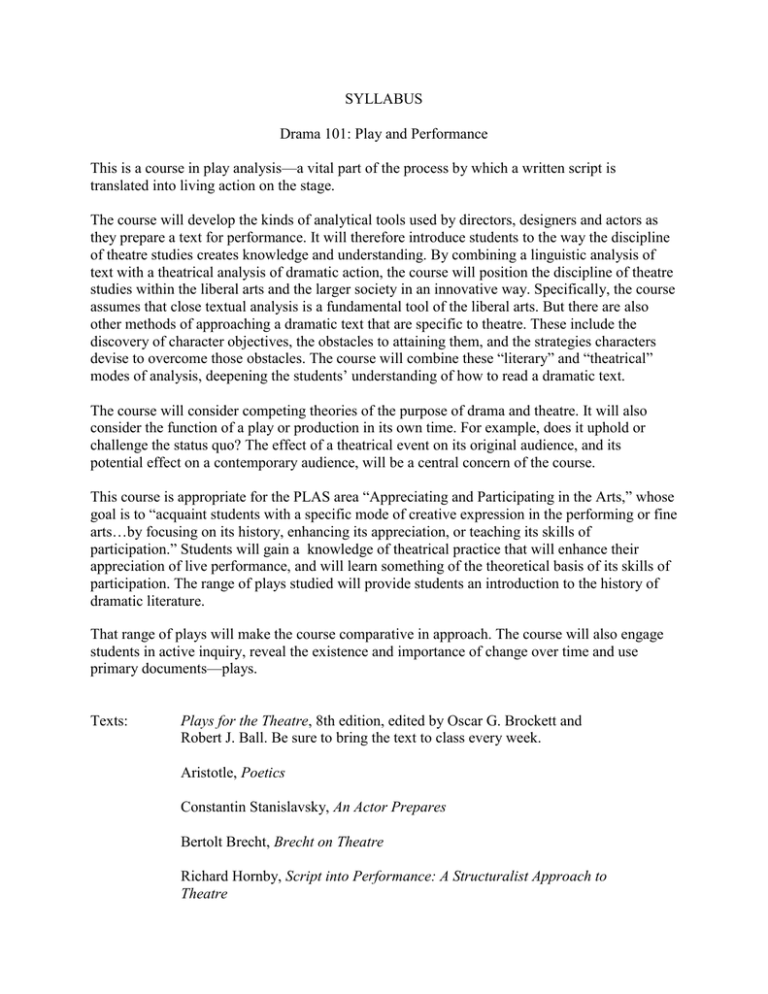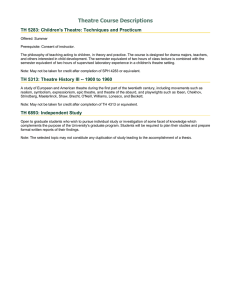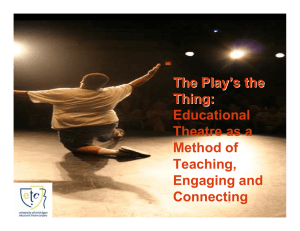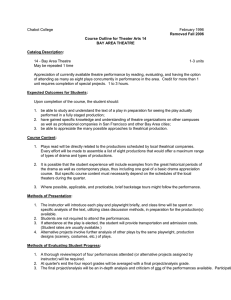SYLLABUS Drama 101: Play and Performance
advertisement

SYLLABUS Drama 101: Play and Performance This is a course in play analysis—a vital part of the process by which a written script is translated into living action on the stage. The course will develop the kinds of analytical tools used by directors, designers and actors as they prepare a text for performance. It will therefore introduce students to the way the discipline of theatre studies creates knowledge and understanding. By combining a linguistic analysis of text with a theatrical analysis of dramatic action, the course will position the discipline of theatre studies within the liberal arts and the larger society in an innovative way. Specifically, the course assumes that close textual analysis is a fundamental tool of the liberal arts. But there are also other methods of approaching a dramatic text that are specific to theatre. These include the discovery of character objectives, the obstacles to attaining them, and the strategies characters devise to overcome those obstacles. The course will combine these “literary” and “theatrical” modes of analysis, deepening the students’ understanding of how to read a dramatic text. The course will consider competing theories of the purpose of drama and theatre. It will also consider the function of a play or production in its own time. For example, does it uphold or challenge the status quo? The effect of a theatrical event on its original audience, and its potential effect on a contemporary audience, will be a central concern of the course. This course is appropriate for the PLAS area “Appreciating and Participating in the Arts,” whose goal is to “acquaint students with a specific mode of creative expression in the performing or fine arts…by focusing on its history, enhancing its appreciation, or teaching its skills of participation.” Students will gain a knowledge of theatrical practice that will enhance their appreciation of live performance, and will learn something of the theoretical basis of its skills of participation. The range of plays studied will provide students an introduction to the history of dramatic literature. That range of plays will make the course comparative in approach. The course will also engage students in active inquiry, reveal the existence and importance of change over time and use primary documents—plays. Texts: Plays for the Theatre, 8th edition, edited by Oscar G. Brockett and Robert J. Ball. Be sure to bring the text to class every week. Aristotle, Poetics Constantin Stanislavsky, An Actor Prepares Bertolt Brecht, Brecht on Theatre Richard Hornby, Script into Performance: A Structuralist Approach to Theatre Class Schedule (Texts should be read by the date indicated. The syllabus does not follow the anthology’s table of contents.) Week 1. Introduction. What is drama? What is theatre? Why do we analyze plays? How do we analyze plays? Week 2. Oedipus Rex. Aristotle’s Poetics. Week 3. Hamlet. The nature of tragedy. Week 4. The nature of comedy. Commedia dell ‘Arte: The Servant of Two Masters. Excerpts from An Actor Prepares. Week 5. As classic as comedy gets. Tartuffe. Additional excerpts from An Actor Prepares. Week 6. The comically serious: Noah and His Sons. Brecht, A New Organum for the Theatre (in Brecht on Theatre). Week 7. Realism: A Doll’s House. Additional excerpts from Brecht on Theatre. Week 8. Expressionism: ‘The Hairy Ape’. Excerpts from Script into Performance. Week 9. Non-Aristotelian theatre: The Good Woman of Setzuan. Additional excerpts from Script into Performance. Week 10. Absurdism: Happy Days. Week 11. Mid-century America: Cat on a Hot Tin Roof. Week 12. Contemporary America: Ma Rainey’s Black Bottom. Week 13. Contemporary America: Roosters. Week 14. Contemporary America: How I Learned to Drive. GRADING 10 analytic exercises at 12 points each—120 points 3-person group project (director, designer, dramaturg)—40 points final exam—40 points. 180-200 points: A range 160-179 points: B range 140-159 points: C range 120-139 points: D range below 120 points: F Cell phones and pagers must be off during class. Cell phones must not be used for any purpose, or even seen. The same goes for laptop computers, which are rarely used for taking notes. If the instructor sees or hears your cell phone, you will lose all credit for your analytic exercise for that class. Keep all graded work I hand back to you until the end of the semester. This is a requirement. It is the only way we can correct grading and credit errors. If you need help, please talk to me! Please inform me of any difficulties you may be having. I will be available during office hours and, if necessary, will make special arrangements. The instructor may change requirements, change the class schedule and change due dates as he deems appropriate. Analytic exercises: Each one should be a single-spaced page. It must be typed, in 12–point size. It should be in two parts: significant elements and unifying principle. (A sample is provided.) The significant elements are those aspects of the play that you feel are not immediately apparent, yet are essential to understanding the work. Basically, we are looking for motifs--recurrent images, phrases, ideas, events, character types--that give the work its coherence. Do not deal with the plot of the play. Do not offer interpretations of the play. Characters’ feelings or emotions are generally not elements in the sense that we are using the term. You must state your elements in complete sentences. Try for around eight elements, although this is not a rule. Page references and examples are essential evidence for all of your significant elements. You should support an element with at least two examples that involve different characters. The unifying principle, placed at the end, is one sentence that you feel sums up the significant elements and the meaning of the play as a whole. Since it is a summation, it should be cogent and short. Maximum length is 20 words. Remember that it is an attempt to tie together as many of the significant elements as possible, without putting them in a list. Try to describe the arc or movement of the play. Do not try to find a message or moral. See the sample. No extensions are possible for these assignments because we will use them in class. They must be brought at the beginning of the class for which a given play is assigned. To receive credit, both you and your analytic exercise must be present in class, and you must read it out loud. You cannot give it to me before class if you are not going to be in class. You cannot give it to me at the start of class and then leave. You cannot give it to somebody else to turn in for you. You cannot e-mail it to me or leave it for me. You must do ten of these assignments out of a possible 13. If you hand in more than ten, I shall count only your best ten and omit the lowest grade or grades. The more you do, the better you will get. Don’t put them off. If you decide you’re going to do only the last ten, I can almost guarantee that circumstances will prevent you. You will undoubtedly have some emergency toward the semester’s end that will keep you from class but you will want to turn in the exercise for that class anyway because you’re behind—remember that you can’t. And if you do only ten, I won’t be able to drop your low grades. Class discussion is important. You are required to read all the plays, coming to class with the text, ready for discussion, even if you are skipping the written assignment. No research is permitted for an analytic exercise. If you use any source except the play itself you will receive no credit. There is no way to make up such an exercise. All the work you do in this course must be entirely your own. Plagiarism or collaboration with another student in any of your assignments will result in your receiving no credit for the assignment. There is no way to make up such an assignment. Sample analytic exercise “Twelfth Night” by William Shakespeare Significant Elements: 1. The title refers to a holiday characterized by gift-giving, disguise, carousing and topsyturveydom. 2. There are many gifts in the play: Olivia sends Viola a ring; Orsino sends Olivia a jewel; Olivia sends Sebastian a pearl; Feste gets tips from Viola, the Duke, Sir Toby and Sir Andrew. 3. There is much disguising in the play: Viola as Cesario, Feste as Sir Topas, Feste’s endless posturing, Malvolio’s reverie in II.v. and later gartered get-up, Maria writing for Olivia. 4. There are many images of fluids throughout the play: references to the sea, tears, liquor, urine, blood, ink, rain, water, ale, gall, the humours, and drowning. 5. In contrast, there are a few references to dryness: to Sir Andrew at I.iii.62-73, III.ii.54-56, Feste at I.v.36. 6. People speak throughout the play of being drawn by their eyes: I.i.20-21, I.v.282-84, II.v.22-23, III.iii.22-24, 40-45, etc. 7. This is related to acts of psychological projection, the characters’ desire to transform others into what they wish them to be. Olivia’s line, “I would you were as I would have you be,” relates to her image of Viola/Cesario, but could refer also to Orsino’s love for Olivia, and Malvolio’s reading meanings into the letter. 8. Projection is also involved in more minor elements, such as Antonio’s confusions about Viola and Sebastian, or the joke about “We three” at II.iii.15. Projection is related to the alternate meaning of the subtitle (“What you will”) and to the important word, “fancy,” which has two meanings—to fantasize and to love. Unifying Principle (root action): In the fluid world of Illyria, characters move from deluded love to true love, from projection to reality. The group projects Each student must participate in one group project on one of the assigned plays. Form a 3-person group and give me your names along with the name of a play on the syllabus on which you want to work. Also pick an alternate title. Failure to pick an alternate will not help you get your selection. If you don’t know other students in the class, I will find partners for you. Be sure to exchange contact information with your partners. Each group should prepare a 15-20 minute presentation on the play. One student should assume the role of director, another of designer in one or two areas (sets, costumes, lights, sound), and the third should be the dramaturg (explained below). The presentation will be given on the date the play appears on the syllabus. If you are absent on that day without acceptable excuse, you will get no credit for the project. If you’re the director or designer, you should describe your approach to staging the play. What effect do you want to have on the audience? What do you want them to get from seeing your production? What aspect of the play do you want to illuminate? What mood, tone or style do you want to create? What “look” do you want? Do you want the audience to laugh, weep, think, sit in stunned silence or run screaming out the door? If you’re the director, what well-known actors would you cast in the leading roles, if you could? Why? Most important: how did the principles of analysis developed in this course influence your artistic decisions? The dramaturg is the research person. She or he should learn about the style of the play’s original production, something about the play’s production history, and find out what some scholars or critics have written. Biographical information about the playwright should not dominate the presentation. The dramaturg should present these findings to the director and designer to aid them in their decisions. He or she will also present them to the class. Therefore, each group will present three separate but related presentations, totaling 15-20 minutes. After the class has a chance to respond, each member of the group will turn in a revised, written version of his or her presentation, which will be graded. These will be due a week after the presentation, and should be around three pages. Dramaturgs must cite the sources of their information. Your grade will be based on your own work only, and will not reflect the effort, or lack of it, of your colleagues. Terms we will use in play analysis These will be explained and discussed as the course progresses. presentational and representational climactic and episodic conflict a) external b) internal c) root root action point of attack plot: inciting incident rising action turning point climax falling action exposition foreshadowing dramatic irony recognition scenes protagonist and antagonist objectives what’s at stake? physicalization of emotions empathy and esthetic distance pity and/or fear catharsis






